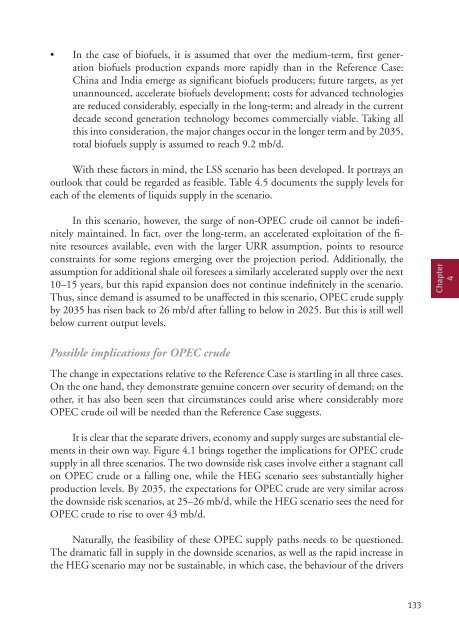World Oil Outlook - Opec
World Oil Outlook - Opec
World Oil Outlook - Opec
- TAGS
- world
- outlook
- opec
- www.opec.org
Create successful ePaper yourself
Turn your PDF publications into a flip-book with our unique Google optimized e-Paper software.
• In the case of biofuels, it is assumed that over the medium-term, first generation<br />
biofuels production expands more rapidly than in the Reference Case:<br />
China and India emerge as significant biofuels producers; future targets, as yet<br />
unannounced, accelerate biofuels development; costs for advanced technologies<br />
are reduced considerably, especially in the long-term; and already in the current<br />
decade second generation technology becomes commercially viable. Taking all<br />
this into consideration, the major changes occur in the longer term and by 2035,<br />
total biofuels supply is assumed to reach 9.2 mb/d.<br />
With these factors in mind, the LSS scenario has been developed. It portrays an<br />
outlook that could be regarded as feasible. Table 4.5 documents the supply levels for<br />
each of the elements of liquids supply in the scenario.<br />
In this scenario, however, the surge of non-OPEC crude oil cannot be indefinitely<br />
maintained. In fact, over the long-term, an accelerated exploitation of the finite<br />
resources available, even with the larger URR assumption, points to resource<br />
constraints for some regions emerging over the projection period. Additionally, the<br />
assumption for additional shale oil foresees a similarly accelerated supply over the next<br />
10–15 years, but this rapid expansion does not continue indefinitely in the scenario.<br />
Thus, since demand is assumed to be unaffected in this scenario, OPEC crude supply<br />
by 2035 has risen back to 26 mb/d after falling to below in 2025. But this is still well<br />
below current output levels.<br />
Possible implications for OPEC crude<br />
The change in expectations relative to the Reference Case is startling in all three cases.<br />
On the one hand, they demonstrate genuine concern over security of demand; on the<br />
other, it has also been seen that circumstances could arise where considerably more<br />
OPEC crude oil will be needed than the Reference Case suggests.<br />
It is clear that the separate drivers, economy and supply surges are substantial elements<br />
in their own way. Figure 4.1 brings together the implications for OPEC crude<br />
supply in all three scenarios. The two downside risk cases involve either a stagnant call<br />
on OPEC crude or a falling one, while the HEG scenario sees substantially higher<br />
production levels. By 2035, the expectations for OPEC crude are very similar across<br />
the downside risk scenarios, at 25–26 mb/d, while the HEG scenario sees the need for<br />
OPEC crude to rise to over 43 mb/d.<br />
Naturally, the feasibility of these OPEC supply paths needs to be questioned.<br />
The dramatic fall in supply in the downside scenarios, as well as the rapid increase in<br />
the HEG scenario may not be sustainable, in which case, the behaviour of the drivers<br />
133<br />
Chapter<br />
4
















